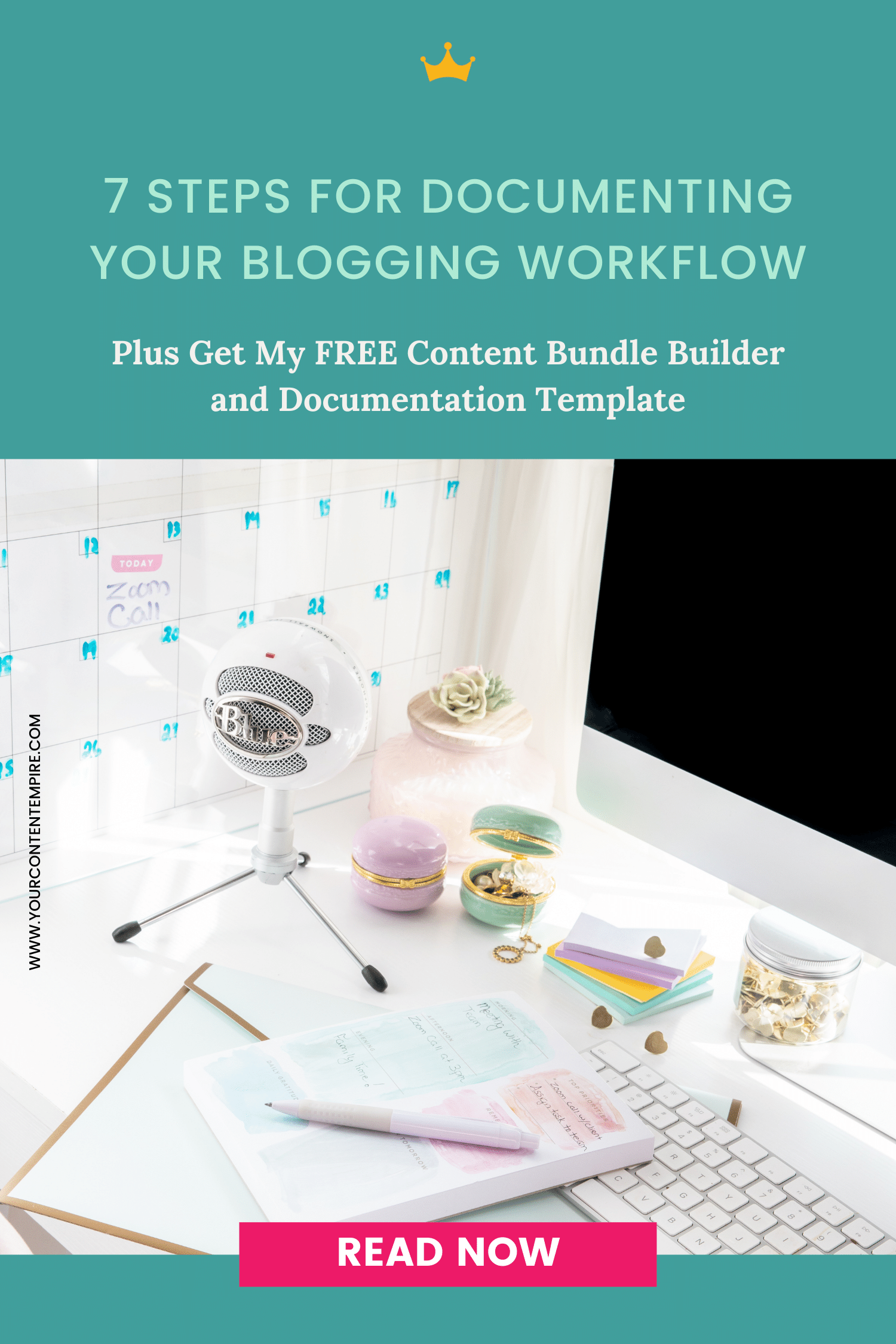Most entrepreneurs I talk to about this feel like they're all over the place with their systems (client workflows, blogging workflows, marketing, etc.) even if that isn't necessarily true.
For myself, I know that I always feel all over the place with my systems and organization even though I know this definitely isn't true. I’ve invested a ton of my time and energy into creating documentation, including templates, checklists, SOPs for team and I to follow.
And yet, this feeling of being disorganized persists and is also completely natural.
True or not, a great place to start with your systems is your blogging system because it’s one of those cornerstone systems that’s really at the heart of your marketing if you're using content marketing to grow your business. And once you nail down that blogging workflow, everything else related to it tends to fall into place.
Benefits of Documenting Your Blogging Workflow
- You're going to get out of that feeling that you're making it up every time that you’re planning, producing, publishing or promoting your blog because you’ll have a step by step process you can follow.
- You're going to be able to easily outsource
My business mentor Amber McCue initially got me hooked with her how to clone yourself methodology. As a recovering control freak, I like the idea that if I'm going to outsource, it's going to be done the exact way I would do it if I were doing it myself (unless it’s something I’m definitely not an expert in). This is my favourite approach to take with systems.
Blogging is one of the first things people start to outsource in their businesses. Because even though you might be the one creating the original piece of content, you definitely don’t need to be a part of everything that goes into getting that piece published and promoted.
- It allows you to master the basics and add on
I'm a big fan of telling people to figure out what is the MVO (minimum viable output) of their content.
As high achieving entrepreneurs, I know we have a tendency of making things as complicated as possible and we can really underestimate the time that something is actually going to take.
And when you don’t stick to the plan because it’s logistically impossible? You feel like a failure and think the problem is with you even though the only thing you did wrong was miscalculate.
I’d much rather you start as small as possible with what you know you’re going to be able to get done easily, with one hand tied behind your back. Once you master that consistently, add on something else. Document your blogging workflow so you can establish what that baseline is and where your golden standards lies.
- It allows you to identify opportunities to simplify and streamline
When you go through the process of writing down every step in your blogging workflow, you’ll naturally find opportunities to streamline your process. There might be templates you can create to avoid having to start from scratch every time. There might be better tools you can use that’ll save you time. Or there might be places you cut entirely before the juice isn’t worth the squeeze.
All of these will allow you shave minutes or even hours off of your blogging process that are going to add up to some major time savings – time that you can be putting into something more important for your business.
Let's go through the steps of how to document your blogging workflow:
Step 1 – Figure out what belongs in your core content bundle
Remember how I said that your blog is the cornerstone of your content marketing strategy? And that once you figure out that your blogging system, in particular, everything else tends to fall into place? Well, this is how that works.
I want to encourage you to shift your thinking around your blog. Instead of thinking of it as an independent piece of content that you're publishing. I want you to elevate its position in your content strategy to the heart at the centre of it all.
First, how frequently are you committing to blogging? Is it going to be something that you do every week (which is what I recommend you work up to)? Is it going to be something that you do bi-weekly, even if that's just a start (my second recommended frequency)? Or are you going to start even smaller by only committing to blogging once per month?
Any of these will work and I want you to choose the frequency that you know you can keep up with easily.
Sidenote – I don't think that you need to necessarily blog any more than weekly either, for the simple fact that every time you put out a blog, you want to make sure that you’re matching the amount of time you took to create that blog post with the amount of time you’re dedicating to promoting it. And if you are creating a blog post more than once a week, promoting it becomes a very time-consuming process. And as a business owner (not a blogger) who uses your blog to build your business, generate leads and stay top of mind with your customers, once a week (or biweekly) is perfectly sufficient.
So once you’ve figured out the blogging frequency you're committing to, the next step is to figure out what core elements are in your regular content bundle. For this example – I’m going to go with weekly.
What is a content bundle?
It’s essentially a package of content that you publish on the same interval. One of the biggest takeaways that my clients and students tell me they’ve had from working together is starting to view their content in terms of bundles. Instead of looking at each piece of content individually, or even by channel, they start to bundle their content pieces together based on how they relate to each other in terms of frequency.
First off, I want to introduce you to your core content bundle, or as I like to call it the content triad. This core content bundle forms the foundation of your entire strategy. It’s the content that you publish on either a weekly or biweekly basis. It’s centered around a single topic.
And it starts with your blog post at the top – regardless of what format you choose for it. Then the other two corners – your newsletter and your social media – direct readers back to your blog post for this great new piece of content.
For the blog post – this includes any pieces that go into getting it on your website – like the blog itself, branded images and any content upgrades.
Then we have the newsletter – this is the best way to let your audience know about your latest and great post. ‘Cause think about it – even though they love you and what you’re up to, it’s not like they’re sitting on your website, hitting refresh every 10 minutes to see if you’ve published something new – you have to tell them about it!
Then we have your social media content – this is one of the best ways (in addition to paid advertising) that we can use to help your content get found and discovered by new audience members.
So what are all the pieces that go into your core content bundle?
Here are some ideas:
- Written blog post
- Video blog post, transcript, cover image
- Blog post images
- Newsletter
- 2 promo messages
I've put together a content bundle builder template that will help map out your core content bundle:
Step 2 – Your Blog Planning Phase
Next, what are all of the things you do as part of your blog planning phase?
Brainstorm the individual tasks that go into this part of your content strategy. Think of things like: how do you choose your topics? Where do you track ideas for future topics? Where do you plan out your editorial calendar?
Then, are there any tools, templates or resources you could set up or use for your blog planning phase that would make the job quicker or easier?
Here’s what this looks like in my business: I create my overall content strategy once per quarter along with revenue plan so this means I have a rough idea of what I’m doing each month, then I’ll create the detailed content plan for the month before I get down to batching, finally we duplicate blog tasks in Asana that contain checklists of subtasks of everything that needs to get done to get the blog post out. The tools I use are: Asana template for each blog post, my 2020 Content Empire Planner, my free writing template and a recurring appointment on my calendar for time set aside to do this planning.
If you want to read my blog post on my monthly content planning process, click here.
Step 3 – Your Blog Drafting Phase
The next phase of your blogging workflow is the drafting phase.
What are all of the things you do in order to draft your blog post?
The actions are going to really depend on what type of blogging you're doing – the steps for a video blog are a lot different than for a written blog or a podcast episode.
For myself, since we are doing written slash YouTube video blog posts this year, our steps for the drafting phase include: free writing for 10 minutes (as soon as I put the topic onto my monthly editorial calendar), conducting any research, finalizing the written post, creating my video storyboards, checking these tasks off on the Asana task dedicated to the specific blog post.
Step 4 – Your Blog Production Phase
Your blog production phase is all the accessory content that goes along with your blog post. So what are all of the individual steps you take during your own blog production phase? And are there any tools, templates and resources you can use or create to make your job easier?
For myself, this phase includes all of the images that go along with my post, proofreading the post, social media copy, and transcripts. So during this phase, I document the steps that go into producing each of these pieces.
Step 5 – Your Blog Publishing Phase
Next up is your blog publishing phase. This is where you’re publishing and schedule out your content – it might be uploading and pre-scheduling your YouTube video, formatting and scheduling your blog post, adding social media posts or email newsletters.
What are all the things you do in order to get your blog and/or core content bundle published? And are there any tools you could use or create to make the job quicker?
Step 6 – Your Blog Promotion Phase
So our next phase is the promotion phase of your blogging workflow. This includes anything that you are doing to promote your blog post. And since you’ve likely already drafted up and scheduled your promo social and email, this phase refers more to your extra social media time and content.
There are so many ways for us to automate, batch and be ahead of the game with our content these days. But I think that batching and automating works best when it's also paired with a little bit of real-time marketing as well.
For you this means anything that can’t be done ahead of time – like sharing in Facebook groups, doing a live on your blog post, etc.
So what are all the steps that you take during your blog promotion phase? And are there any tools or templates you can use (or create) to make your job easier?
Step 7 – The Blogging Workflow Rehearsal
So I mentioned that one of the best things about your blogging workflow is that it allows you to outsource. But even if you're eager to get outsourcing, hold your horses because I want you to actually go through this entire process from start to finish yourself.
This will give you an opportunity to record yourself going through it so that you have extra training support that is going to make it easier to outsource and so you're not needing to train one on one with somebody. Plus if you have a VA leave, it’ll be much easier to find someone new to fill their spot, if you’re worried about having to train again.
So hit the blank doc and get creating your next blog from start to finish!
Are you ready to start documenting your blogging workflow?
Start by downloading my content bundle builder template so that you can start brainstorming your frequency of blogging bundles, as well as what exists in those there. It's a great first step to starting your blog documentation process. ♀️ And here's to cloning yourself!







